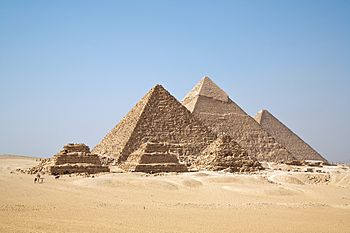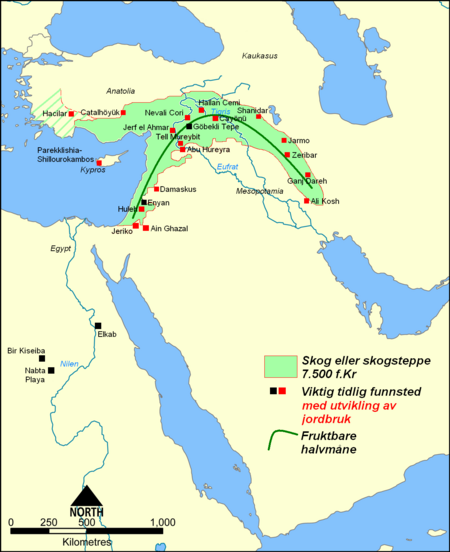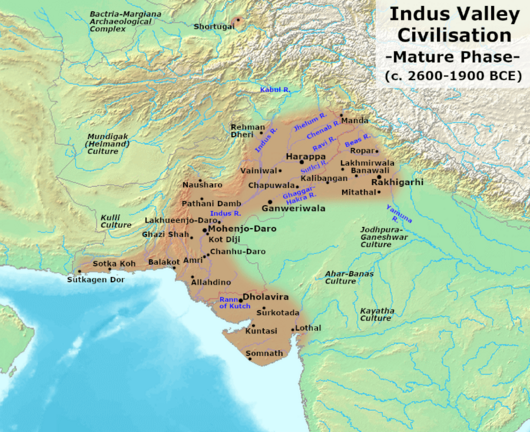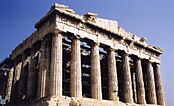Cradle of civilization facts for kids
A cradle of civilization is a place and culture where civilization first developed on its own. A civilization is a complex society with a government, cities, and ways to communicate beyond talking, like writing or art.
Experts generally agree on six main cradles of civilization. These include Mesopotamia, Ancient Egypt, Ancient India, and Ancient China in Afro-Eurasia. In the Americas, the earliest were the Caral–Supe civilization in coastal Peru and the Olmec civilization in Mexico. All these cradles relied on agriculture to feed their people. Farmers grew extra food, supporting leaders and public projects in early cities.
Less formally, the term "cradle of Western civilization" often refers to other ancient civilizations like Greece or Rome.

Contents
How Civilizations Began
The first steps towards settled life appeared in the Levant around 12,000 BC. People started living in one place and farming by 10,000 BC. Water was very important for a steady food supply. This led to permanent villages.
The earliest large settlements, or proto-cities, appeared in Western Asia around 10,000 BC. Some of the first cities, like Uruk in Mesopotamia, grew to tens of thousands of people by the 31st century BC.
We call times "historic" when people started keeping written records. This often means when writing developed. Early examples are from the Near East around 4000 BC. Harappa in the Indus Valley also had early writing around 3300 BC. Chinese and Mesoamerican writing systems followed later.
Most of what we know comes from archaeology. A civilized way of life is strongly linked to agriculture. Farming allowed people to settle and produce extra food. This led to larger towns, specialized jobs, and organized societies. It also helped develop writing and big public buildings.
Many Beginnings of Civilization
At one time, some experts thought civilization started in just one place, the Fertile Crescent. But now, most experts think civilizations began on their own in several different places around the world. These developments happened at different times.
The idea of a "cradle of civilization" focuses on places where people started to build cities. They also created writing systems, learned to make pottery and use metals. They began to domesticate animals and developed complex social systems with different social groups.
Today, experts usually point to six main areas where civilization started independently. These are the Fertile Crescent (which includes Mesopotamia and the Levant), the Nile Valley, the Indo-Gangetic Plain, the North China Plain, the Andean Coast, and the Mesoamerican Gulf Coast.
Cradles of Civilization Around the World
The Fertile Crescent: Where Farming Began
The Fertile Crescent is a curved area of land in West Asia. It includes parts of modern-day Egypt, Israel, Palestine, Lebanon, Syria, Jordan, Turkey, and Iraq. This region was one of the first places where people started farming. This led to settled farming communities.
Around 10,200 BC, advanced Stone Age cultures appeared here. One famous early settlement is Jericho in the Jordan Valley. It is thought to be one of the world's earliest cities, settled around 9600 BC.
Many experts believe the Fertile Crescent was the first cradle of civilization. Early sites include Göbekli Tepe and Çatalhöyük.
Mesopotamia: Land Between Two Rivers
Mesopotamia is a region in modern Iraq and nearby areas. It lies between the Tigris and Euphrates rivers. These rivers created rich, fertile soil and provided water for farming. This made it a perfect place for early farming societies to grow.
The Ubaid period (around 6500 to 3800 BC) was key. People started building larger towns. Farming and raising animals became common. Irrigation was used for crops.
The Sumerian civilization grew during the Uruk period (4000 to 3100 BC). City life began in Mesopotamia then. The cuneiform script, an early writing system, also appeared. Cities were likely led by priest-kings.
The Jemdet Nasr period (3100 to 2900 BC) was important for writing. Cuneiform changed from pictures to wedge-shaped signs. Trade networks grew.
Later, during the Early Dynastic Period (around 2900 BC), leaders called "Lugals" gained more power. Legendary figures like Gilgamesh are from this time. The first ziggurats, large temple towers, also began to be built.
Around 2500 BC, Eannatum, a Sumerian king, created an early empire. Later, the Akkadian Empire rose under Sargon the Great around 2350 BC. Akkadians adopted Sumerian culture. Powerful nations like Assyria and Babylonia emerged. The Sumerians blended into these groups.
Ancient Egypt: Gift of the Nile
Around 8000 BC, climate changes made northern Africa drier, forming the Sahara desert. This led early Egyptians to settle permanently along the Nile River for farming.
By 5500 BC, groups in the Nile valley grew into related cultures. They mastered agriculture and animal husbandry. The Badari culture was known for its pottery. The Naqada culture followed, bringing new technologies.
Egyptian civilization began around 3500 BC. It grew stronger with the unification of Upper and Lower Egypt around 3150 BC. King Narmer united these two kingdoms. More food from farming led to larger cities.
During the Early Dynastic Period (around 3150 to 2686 BC), the capital moved to Memphis. A unified Egypt was ruled by a powerful pharaoh, who was seen as a god-king. This period saw the start of famous Egyptian art, architecture, and religious practices.
The Old Kingdom (around 2686 BC onwards) brought major advances. The famous Giza pyramids and Great Sphinx were built. Officials managed taxes and projects. The pharaoh's power lessened, and regional governors gained influence. This, with droughts, led to challenges.
Ancient India: The Indus Valley Civilization
The earliest farming site in South Asia is Mehrgarh in modern Pakistan, dating to 7000 BC. This area showed early farming and animal herding. It likely led to the Indus Valley Civilisation.
The Indus Valley Civilization began around 3300 BC. Early examples of the Indus script appeared then. Towns also started to have central authority.
From 2600 to 1900 BC, the civilization reached its peak. Villages grew into large cities like Harappa and Mohenjo-daro. These cities had amazing engineering, including early urban sanitation systems. Homes had wells, and waste water went into covered drains.
The Harappans were skilled builders. They created impressive dockyards and protective walls. They were accurate in measuring, using uniform weights and measures.
Around 1800 BC, the Indus Valley Civilization began to decline. By 1700 BC, most cities were abandoned. Experts believe climate change was a main reason. Weaker monsoon rains led to droughts, making farming difficult. People migrated to smaller communities, and cities declined. Many parts of the civilization continued in later Indian cultures.
Ancient China: Along the Rivers
Chinese civilization developed from many interacting cultures. Key regions were the Yellow River, Yangtze, and Liao areas. Early farming of millet (around 7000 BC) and rice (around 6500 BC) is found here. Chengtoushan may have been China's first walled city.
The Peiligang culture (7000 to 5000 BC) in the Yellow River valley was important. They farmed, built homes, and made pottery. Agriculture led to more people. Some Jiahu symbols might be early writing.
The Yangshao culture (5000 to 3000 BC) followed, with polished stone tools. They may have raised silkworms. The Longshan culture (3000 to 1900 BC) saw a big population increase with strong rammed earth walls.
Modern Chinese civilization began during the Erlitou period (1900 to 1500 BC). Erlitou is seen as the first state-level society in East Asia. It saw more bronze making and city growth. Its link to the legendary Xia dynasty is debated.
The Shang dynasty (1600 to 1046 BC) is the first Chinese dynasty with both archaeological and written proof. Shang sites have the earliest Chinese writing on oracle bones. These writings tell us about their politics and life. The Sanxingdui culture also existed then.
Ancient Andes: Peru's Early Cities
The first signs of farming in the Andean region are from Ecuador around 9000 BC. Early canal irrigation in South America dates to 4700 BC in Peru. The earliest cities in the Americas, like Caral, appeared around 3500 BC.
The Caral–Supe or Norte Chico civilization emerged around 3200 BC. It is the oldest known civilization in the Americas. It thrived near the Pacific coast in river valleys, with cities like Caral and Aspero.
Norte Chico had no pottery or much visual art. Yet, it built amazing structures, including large earthwork mounds and sunken circular plazas. They also had an advanced textile industry. These buildings show a society with central leadership, managing resources like cotton.
While farming was key, they also relied on food from the sea. There is no evidence of warfare. Leaders likely had power from their connection to gods. Building structures might have been a spiritual experience.
Bundles of strings called quipu were found. These were used for recording information. Quipu suggest a link to later Andean cultures.
Around 1800 BC, Norte Chico began to decline. New centers appeared elsewhere. The Chavín culture later became a major Andean civilization, centered at Chavín de Huantar around 900 BC.
Mesoamerica: The Olmec Civilization
Maize (corn) was first grown in southern Mexico around 7000 BC. The Mokaya people domesticated cacao around 1900 BC. They were among the first to have a society with different social levels.
The Olmec civilization began around 1600 to 1500 BC. It first grew in San Lorenzo Tenochtitlán around 1400 BC. Rich soil and river networks helped population growth. This led to an elite class, who demanded special items.
Olmec art is famous, especially their huge Olmec colossal heads. These stone heads show the power of their leaders. San Lorenzo was a ceremonial site. Around 900 BC, it was mostly abandoned, possibly due to environmental changes.
La Venta then became the main Olmec center until about 400 BC. It featured impressive buildings, like the Great Pyramid. La Venta was controlled by a king and powerful priests. Building colossal heads showed leaders could organize workers.
The Olmec culture declined between 400 and 350 BC. This was likely due to major environmental changes, affecting their rivers. The Olmecs are often called the "mother culture" of Mesoamerica. They laid foundations for later civilizations like the Maya and Aztec. They introduced practices like special ceremonies and the Mesoamerican ballgame.
The Cradle of Western Civilization
The roots of Western civilization are found in the ancient Mediterranean world. Classical Greece was a very important culture. It laid the foundation for modern Western philosophy, democracy, art, science, and architecture.
Ancient Rome is also called a cradle of Western Civilization. This is because of its big role in politics, government, law, architecture, and warfare. Roman culture, especially through the Roman Empire, helped spread Greek ideas throughout Europe.
Western Civilization is also linked to Christianity. This religion started from Judaism. Christian beliefs and ethics, influenced by Jewish traditions, have greatly shaped Western societies. So, Western civilization is seen as a mix of Greek, Roman, and Judeo-Christian traditions.
Other Meanings of "Cradle of Civilization"
The phrase "cradle of civilization" is sometimes used in different ways. It can be used to express national pride. For example, it has appeared in discussions about Indian nationalism and Taiwanese nationalism.
Sometimes, the term is used in less scientific ways. For instance, some books or ideas might claim the title for other places, like "the second Eden" or ancient Britain. These uses are different from how historians and archaeologists use the term.
See also
 In Spanish: Cuna de la civilización para niños
In Spanish: Cuna de la civilización para niños
- Chronology of the ancient Near East
- Cradle of Humankind
- Four Great Ancient Civilizations
- River valley civilization
- Human history
- Civilization state
- Skara Brae and Barnhouse Settlement
- Old Europe (archaeology)










